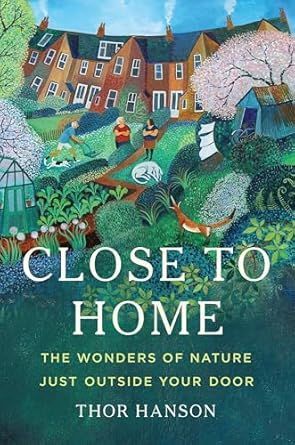Keep Calm and Read On: Think Small
By Wayne Limberg

Thor Hanson throws readers a curve at the start of "Close to Home" when he suggests they close the book and go sit under a tree. Hanson is an award-winning conservation biologist and Guggenheim fellow whose previous books include "Buzz," "Feathers," and "The Triumph of Seeds." All are serious but readable scientific studies. "Close to Home" takes a different tactic. It is at once a shout out to "citizen naturalists" and a call to action.
Hanson got the idea for "Close to Home" one morning as he walked from his house to his "office shack" on San Juan Island in Washington and heard a hermit thrush singing in the underbrush, the same bird that grabbed the attention of such poets as T.S. Eliot and Walt Whitman. His first reaction was to make a mental note to investigate the bird when he finished his work that day when it suddenly hit him that this was his work. He had traveled the world studying such creatures as Ugandan gorillas but had not really paid attention to the marvels at his doorstep. Over the next decade he worked to remedy that. The result was "Close to Home."
Hanson divides "Close to Home" into three major sections. The first is "Seeing." Hanson argues that the demands of modern civilization have forced humans to neglect many of the skills developed over millenia of evolution. When it comes to nature, most humans are rank amateurs when compared to the likes of the San hunters of Namibia and Botswana who can identify over 220 animals and 150 edible plants. Hanson holds that it is time to relearn old skills of observation. The good news is that the best classroom is just outside our back doors. Thoreau seldom ventured far from Walden Pond. After returning from his cruise on the "Beagle," Darwin continued his studies in his garden. The key is to "think small" and take the time to see, listen and smell. A good way to start is to crawl across your lawn. Or simply sit on the deck or patio and look and listen.
Hanson guarantees this will be transformative for individuals and society. When Covid forced people to stay at home, they began to seek relief in nature. The more they experienced the natural world, the more they wanted to learn—and share. The numbers of "backyard naturalists" grew. With that growth, came an unexpected expansion of a swath of research data bases as these new "citizen scientists" went online and reported their findings. The Great Sunflower Project, which tracks bees, for example, was deluged by reports. This has had a revolutionary impact on biological research. Scientists no longer have to necessarily spend time on the ground compiling data. It is available online. Researchers in many fields report a backlog of reports and data.
In "Exploring," the second section of "Close to Home," Hanson makes the case for applying the newly learned ability to "get small" to examining nature at all levels. Hanson notes that one of the most surprising aspects of "backyard biology" is not the number of small things living alongside us but the number that have gone unnoticed even by trained scientists. Compilation of community data collections based on reporting from “citizen scientists" has led to the recognition of thousands of new critters and what one of the scientists Hanson interviewed for the book called "the democratization of science." To sustain and expand this, we have to approach nature with an open mind in order to discover new species and their habits. He explains how this can be done in four chapters, which amount to a how-to guide as well as a survey of cutting edge academic work.
The final section of "Close to Home" deals with restoring the natural world at our doorsteps. How “backyard naturalist” might "lay out the welcome mat" to attract and maintain new species to their yards and parks, be it by planting milkweed to attract monarch butterflies, turning off deck lights, or building birdhouses. In this section, Hanson’s refreshing optimism comes into full play. In this section he underscores his belief in Nature's resilience. The book hit the shelves in early 2025. It would be good to know if that optimism has diminished as research budgets and other nature-oriented programs have been cut.
"Close to Home" could easily be read over a weekend but that would defeat Hanson's intentions. He wrote the book as a companion, not to be read and shelved. Hanson writing has a conversational style infused with a self-deprecating sense of humor. He clearly enjoyed writing the book, packing it with quotes from sources ranging from Cervantes to Nietzsche. He cleverly intertwines serious interviews with world-class scientists and homespun observations.
Hanson includes 20 pages of endnotes, which are not only a sign of serious research but a good read in themselves. He also includes a 20-page bibliography and a useful appendix on citizen science resources available online. Early in the book, Hanson recommends an additional resource for exploring the natural: children. They are curious and untainted by conventional wisdom--and closer to the ground. If you don't have one, borrow one.
As the holidays near, do you have a good suggestion for a gift book? Kids’ and young adult books are especially welcome. If so, send them along to wplimberg@aol.com. See you on the trail.
<<Previous Article Back Home Next Article>>
